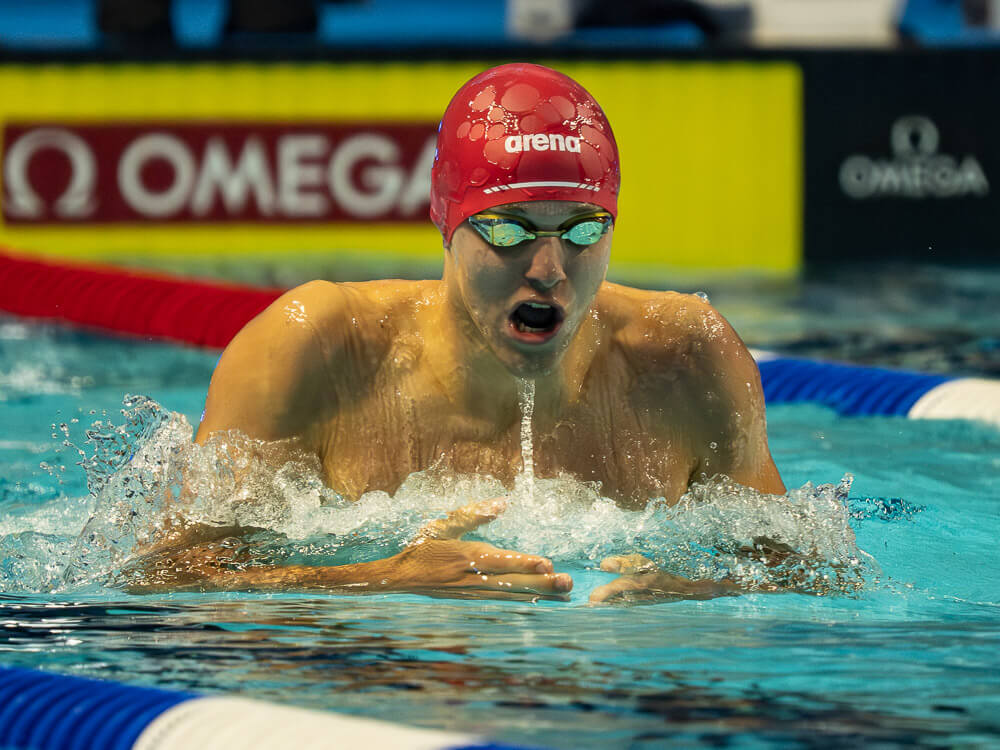Maximus Williamson, Madi Mintenko Become Junior-Level U.S. Relay Heroes

Maximus Williamson, Madi Mintenko Become Junior-Level U.S. Relay Heroes
He dove into the water in fourth place, some seven tenths off the lead, but by the time Maximus Williamson completed the second leg on the U.S. men’s 400 freestyle relay at the World Junior Championships in Netanya, Israel, the Americans had a commanding lead, one which they would not relinquish on the way to a gold medal and world junior record. Williamson’s split was a remarkable 47.78, seven tenths faster than anyone else in the field, even with Flynn Southam anchoring for Australia.
Williamson, racing on his 17th birthday, eclipsed his flat-start best time of 48.84, established one month earlier at U.S. Junior Nationals, by more than one second. But the full story is even more impressive than that: Williamson had not broken 50 until the start of U.S. Nationals in late June. Here is his progression in the 100 free over the past year.
| Date | Time |
| July 29, 2022 | 50.14 |
| May 18, 2023 | 50.13 |
| June 27, 2023 (prelims) | 49.00 |
| June 27, 2023 (final) | 48.91 |
| August 3, 2023 | 48.84 |
All the sudden, a 47-point relay leg to give the American men their first gold medal of the meet? The Lakeside Aquatic Club swimmer set five 15-16 National Age Group records over the last year, but this was Williamson’s first true big-time moment. As a key player in the remaining relay events and a medal favorite in his two individual swims, the 100 free and 200 IM, Williamson could earn a strong medal haul in Netanya, with bigger ambitions beyond the junior level within sight.
Meanwhile, the men’s relay was followed by the women in the 800 free relay, and over the first three legs of the race, no one had achieved a Williamson-esque split to pull away from the field. With 200 meters remaining, the Americans had a lead over Australia but just by two hundredths, with Canadian anchor Ella Jansen less than one second adrift. So the result was in the hands of the youngest swimmer on any of the top-three teams, American Madi Mintenko.
Mintenko, who turned 16 last month, is the daughter of a pair of two-time Olympic swimmers, American Lindsay (Benko) Mintenko, now the managing director of the U.S. national team, and Canadian Mike Mintenko. The younger Mintenko, who represents Pikes Peak Aquatics, first raced internationally in 2022 as part of the Junior Pan Pacific Championships team, but her improvements in the 200 free in recent months put her in position to contribute to this group. Her improvement culminated with a win at Junior Nationals last month, where she swam a time of 1:58.07 for a lifetime best by more than a second.
| Date | Time |
| July 27, 2022 | 2:00.64 |
| April 13, 2023 | 2:00.59 |
| May 19, 2023 | 2:00.47 |
| June 28, 2023 (prelims) | 1:59.53 |
| June 28, 2023 (final) | 1:59.26 |
| August 3, 2023 | 1:58.07 |
As Mintenko began her relay anchor leg in pursuit of gold, Australian anchor Amelia Weber immediately took over the lead. She was three tenths clear by the time the swimmers were halfway through their leg, with Canada’s Jansen having made up most of the deficit as well. Mintenko fought on the third 50 until she and Weber were nearly deadlocked with one length remaining, and the young American ended up getting the job done, with the Americans finishing in 7:52.48, two tenths ahead of Australia. Mintenko’s split of 1:57.45 behind only Jansen’s 1:56.92 in the entire race. The Americans
Mintenko will not have another chance to lower her flat-start 200 free time this week, with the 400 free as her only individual race, but as with the aforementioned Williamson, we must now consider Mintenko’s potential in a grander context. They each proved their trustworthiness in critical moments with relay gold medals, considered the most prestigious when representing the U.S. internationally, at stake. They each issued warnings of their potential to impact the racing at the 2024 U.S. Olympic Trials, now just nine-and-a-half months away.
Admittedly, their flat-start times have yet to reach the level surely required for their potential qualification for the Paris Games as teenagers, but check out that improvement track, with neither at an age where such drops tend to cease. Events 200 meters and shorter are contested with a three-round format at the Olympic Trials, and both have already reached semifinal level in their respective events. One good race, and they make the final, where six out of eight swimmers are likely to receive Olympic selection. And if these relay performances are any indication, neither will be overwhelmed by the big moment.
Declaring a “relay hero” immediately evokes memories of Jason Lezak’s famous come-from-behind anchor leg on the U.S. men’s 400 free relay at the 2008 Olympics, when the 32-year-old Lezak recorded a split that remains history’s fastest (46.06) in a stunning win over France. More recent examples of American heroics include Zach Apple’s pair of gold-clinching anchor legs at the Tokyo Olympics and Bella Sims beating her best time by almost three seconds while anchoring the American women to an 800 free relay world title last year. There’s also pretty much any relay split Australia’s Kyle Chalmers uncorks, including a 46.56 anchor leg on a title-winning men’s 400 free relay at this year’s Worlds.
Of course, a World Junior Championships is several steps shy of the senior-level showcase, but let’s not discount what Williamson and Mintenko accomplished Monday. In the first international relay opportunity for both, they swam faster than ever before while under immense pressure, boosting their own respective swimming profiles as the notion of qualifying for the Olympic Games becomes ever more realistic.



